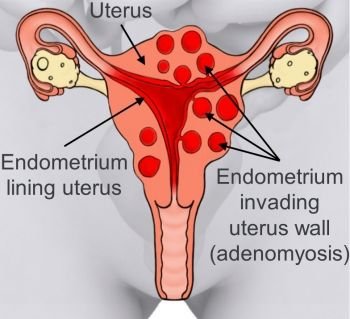Exploring Adenomyosis
Adenomyosis, a condition often eclipsed by its more renowned counterpart endometriosis, deserves recognition and understanding in its own right. Beyond the surface symptoms of heavy bleeding and pelvic pain lies a complex landscape of diagnostic challenges, fertility implications, psychosocial impacts, and ongoing research efforts. My hope is to help you uncover the multifaceted nature of adenomyosis and empower those affected by this often-misunderstood condition.
Understanding Adenomyosis
At its core, adenomyosis involves the infiltration of endometrial tissue into the muscular wall of the uterus, leading to an enlarged uterus and a myriad of symptoms. Unlike endometriosis, where the tissue grows outside the uterus, adenomyosis affects the uterine wall directly, resulting in heavy menstrual bleeding, severe cramps, and chronic pelvic pain.
Prevalence in Australia
While precise figures are elusive due to underdiagnosis, it's estimated that around 20-30% of women of reproductive age in Australia may be affected by adenomyosis to some extent. Women affected are usually aged 40-55, but more and more cases are happening in earlier adulthood and even teenage years. However, due to symptomatic similarities with other conditions and the reliance on invasive diagnostic procedures, many cases go undiagnosed or misdiagnosed, prolonging the suffering of those affected. Definitive diagnosis can only be made after hysterectomy.
Endometrial tissue starts growing within the muscle wall of the uterus
Symptoms
Common symptoms of adenomyosis include:
Painful periods: Over-proliferation of the endometrium during the luteal phase can lead to excessive cramping during the bleed to help expel the endometrial lining.
Heavy bleeding: Many women suffer with flooding, clotting and spotting between cycles. Blood loss can exceed 200ml during a cycle.
Pain during intercourse: Depending on the extent of lesion infiltration, the uterus becomes ‘bulky’ and swollen, causing lower abdominal pain during intercourse.
Iron deficiency anaemia: Due to excessive blood loss, low energy is common and iron supplementation or infusions are often required.
Treatment Options
Currently, treatment for adenomyosis primarily focuses on symptom management rather than a cure. The three main approaches include:
Medication: Used symptomatically and prescribed by your Doctor, can help prevent excessive blood loss associated with adenomyosis. They are relatively safe options which can help manage symptoms while you work on other treatment options.
Hormonal Birth Control: Utilising hormonal contraceptives such as oral pills, intrauterine devices (IUDs), or implants can help reduce bleeding, and alleviate symptoms associated with adenomyosis by stopping the hormones driving the condition. While not a cure, hormonal birth control provides significant relief for many women.
Hysterectomy: Reserved for severe cases where symptoms are debilitating and other treatments have failed, hysterectomy involves the surgical removal of the uterus and is the only known ‘cure’ for adenomyosis. While effective, it's a major procedure with implications for fertility and hormonal balance, necessitating careful consideration.
From a naturopathic approach, we focus on balancing hormones, in particular oestrogen which is known to drive adenomyosis proliferation. Herbal medicines such as Ladies Mantle, Cinnamon. Tienchi Ginseng and Shepherds Purse are excellent uterine tonics that work in different ways to help reduce bleeding and uterine bulk. Reducing inflammation in the body remains important and goes hand in hand with pain management in many women.
Beyond the Basics: Lesser-Known Challenges
While heavy bleeding and pelvic pain are hallmark symptoms, adenomyosis presents a host of lesser-discussed challenges:
Diagnostic Hurdles: Adenomyosis is notoriously difficult to diagnose definitively without invasive procedures, leading to delays in treatment and frustration for patients. Pelvic ultrasounds can be quite uncomfortable and invasive, and lesser used MRI’s are often cost-prohibitive or difficult to access for regional patients.
Impact on Fertility: While not directly causing infertility, adenomyosis can impair fertility and increase the risk of pregnancy complications, necessitating careful family planning and counselling.
Psychosocial Toll: Chronic pain, fatigue, and anxiety over unpredictable symptoms can take a toll on mental health and overall well-being, highlighting the need for holistic care approaches.
Research and Innovation: Ongoing research endeavors aim to unravel the complexities of adenomyosis and develop novel treatment strategies, offering hope for improved outcomes in the future.
Empowering Awareness and Support
Raising awareness about adenomyosis is essential for early diagnosis, access to appropriate treatment, and fostering supportive communities. By shedding light on the nuances of this condition, we empower individuals to advocate for their healthcare needs, seek support from peers, and navigate the challenges of living with adenomyosis.
Let's continue the conversation and share our stories. Speak up if you’re having uncomfortable menstrual symptoms - talk to your Doctor or healthcare provider. We don’t have to suffer in silence.
x

